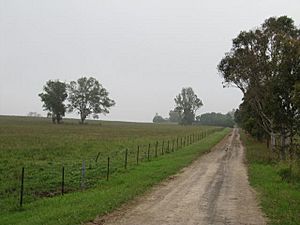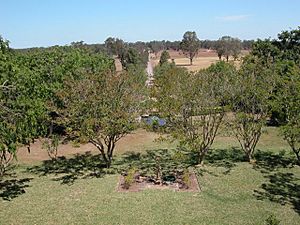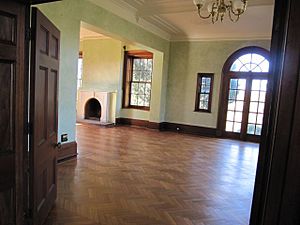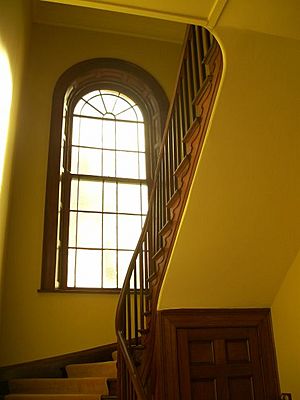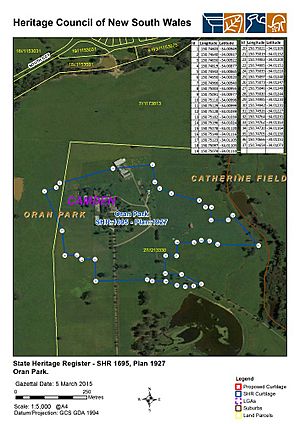Oran Park (homestead) facts for kids
Quick facts for kids Oran Park |
|
|---|---|
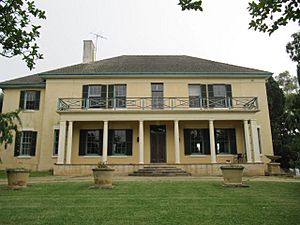 |
|
| Location | 112–130 Oran Park Drive, Oran Park, Camden Council, New South Wales, Australia |
| Built | 1837–1946 |
| Architectural style(s) |
|
| Official name: Oran Park; Catherine Park House | |
| Type | State heritage (complex / group) |
| Designated | 5 March 2015 |
| Reference no. | 1695 |
| Type | Homestead Complex |
| Category | Farming and Grazing |
| Lua error in Module:Location_map at line 420: attempt to index field 'wikibase' (a nil value). | |
Oran Park is a very old and important house located in the south-western Sydney suburb of Oran Park, Australia. It was built between 1837 and 1946. This special place has been many things over the years, including a private home, a golf clubhouse, and even part of a golf course. Today, it is a private residence again. Sometimes people call it Catherine Park House, but its official name is Oran Park. It is recognized as a significant historical site and was added to the New South Wales State Heritage Register on 5 March 2015.
Contents
A Journey Through Time at Oran Park
Early Days: Finding New Land
After the first settlers arrived in Sydney in 1788, they soon realized the soil near the coast wasn't great for farming. They began exploring further west and, by 1795, discovered a rich area called the Cowpastures. This name came from a herd of wild cows that had escaped and were found grazing there. The settlers thought this land, with its gentle hills and wide grassy areas, looked a lot like the beautiful parks in England. It was perfect for creating large, wealthy estates.
Land Grants and Early Owners
Soon, important people wanted to own land in this fertile region. Governor Lachlan Macquarie started giving out land grants. In 1815, Captain William Douglas Campbell received a huge piece of land, about 809-hectare (2,000-acre), which he named Harrington Park. The area where Oran Park house now stands was open land used for farming and raising animals back then.
After Captain Campbell passed away in 1827, his nephew, John Douglas Campbell, inherited part of the land. He began building a house and other buildings, like a coach house, around c. 1837. Later, in 1839, the property was leased to Henry Keck, who was in charge of Darlinghurst Gaol. He agreed to finish building Oran Park house as part of his lease.
Changes and New Owners
In 1842, Henry William Johnson took over the lease. He bought the land and buildings, and it's believed he finished the main construction of Oran Park house around c. 1865. Johnson lived there until 1867, but he ran into financial trouble and lost the property to Thomas Barker.
By 1871, when Edward Lomas Moore bought Oran Park, the house needed a lot of work. Moore was a wealthy farmer and a big landowner in the Campbelltown area. He lived at Oran Park with his large family until his new house, Badgally, was ready. In 1882, he leased Oran Park to Thomas Cadell, who used it as a dairy farm.
Modernizing the Homestead
After Moore's death, his son Essington Moore eventually took ownership in 1907. He made Oran Park his permanent home in the 1930s and made some changes to the house, like updating the roof. When he died suddenly in 1937, Hubert Harry Robbins bought the property. Robbins had big plans to turn Oran Park into a country retreat for his family. He made many important changes, transforming the house from its original Victorian Italianate style to a more classic Georgian Revival look.
After Robbins passed away in 1945, Oran Park changed hands several times. Daniel James Cleary, who started the famous Oran Park Raceway nearby, owned it briefly. Later, in 1961, Edward Star bought the property. He developed it into an 18-hole golf course with a function center, and Oran Park house became the golf clubhouse!
A Racing Enthusiast's Home
In 1969, a man named Lionel John Charles Seymour Dawson-Damer bought Oran Park. He was an engineer and loved motor racing, both in Australia and around the world. He was drawn to Oran Park because it was so close to the Oran Park Raceway. It's said he kept his amazing collection of historic cars in the stables and other buildings on the property.
When Dawson-Damer and his wife, Ashley, bought the house, it was in poor condition. They worked hard to restore the house and its outbuildings, including the old coach house. They also brought the gardens back to life and restored the historic driveway. Sadly, John Dawson-Damer passed away in a racing accident in 2002. Since then, Oran Park has had a few different owners. Today, the driveway has been shortened and connects to a local street called Seidler Parade.
Exploring Oran Park House and Gardens
The Homestead's Grand Setting
Oran Park house sits on a noticeable hill, surrounded by open fields. You used to approach it by a long, straight driveway that ended in a formal loop for carriages. This high position made the house stand out and offered beautiful views of the surrounding countryside and other historic estates.
The Oran Park property still has the main house, a coach house, lovely gardens, and its driveways.
Beautiful Gardens and Trees
The house is surrounded by a large country garden, mostly green lawns with scattered bushes and special trees. Some of these trees are very old, dating back to the Victorian era (the late 1800s). You can find a Bunya Bunya pine (Araucaria bidwillii), Mediterranean cypress (Cupressus sempervirens), and white cedar trees (Melia azederach var. australasica). There are also old Brazilian Peppercorn trees (Schinus molle var. areira).
Later plantings from the 20th century include Hoop pine (A.cunninghamii) and Chinese elms (Ulmus parvifolia). Many of the garden areas around the house show the work done by the Dawson-Damer family in the mid-to-late 1900s. They planted things like Cape chestnut (Cupania capensis) trees and hedges of Cape honeysuckle (Tecomaria capensis). There's even a kitchen garden area to the west of the house, surrounded by hedges.
The Main House
Oran Park is a two-story house with an extra wing at the back. It was first built in the Victorian Italianate style, which was popular for its decorative features. However, it was changed a lot later on and now looks like a Georgian Revival style house, known for its balanced and classic design. At the back, there's a courtyard enclosed by stone walls, and a well or cistern is hidden beneath the paving. A small cottage for a caretaker is also located behind the main house.
The Coach House
The coach house is a single-story building located to the east of the main house. It was originally two stories tall and built with the same type of bricks as Oran Park house. This building would have been used to store carriages and house horses in the past.
How Oran Park Has Changed
The House's Condition
Today, Oran Park house is in good condition. Caretakers live on-site to look after the house and keep it safe.
Over its long history, the house has been changed quite a bit. The biggest change was when it was updated from its original Victorian Italianate style to the Georgian Revival look. While some original parts of the house still exist, these many changes show how the building has evolved and been used differently over time.
Key Changes Over the Years
- 1907–1937: Essington Moore undertook some modifications on Oran Park house, including reconfiguring the roof.
- 1937–1945: Hubert Harry Robbins undertook significant alterations and additions at Oran Park House and converted the Victorian Italianate house into a Georgian Revival style building. The rear basement was converted to a garage.
- 1960: The larger Oran Park property was divided into 26 smaller "hobby farms."
- 1961: A trotting track and an 18-hole golf course were built, and Oran Park house became the golf clubhouse.
- 1969: John Dawson-Damer and his wife restored Oran Park house and coach house. They also brought back the historic driveway and built a swimming pool.
- 1990: The Dawson-Damer family carried out more renovations.
Why Oran Park is a Special Heritage Site
Oran Park is recognized as a very important historical site in New South Wales. It helps us understand the history of the region. Here's why:
A Glimpse into Early Colonial Life
Oran Park is a great example of an early "cultural landscape" in New South Wales. It was part of a huge land grant given by Governor Lachlan Macquarie in 1815. This shows how the Cowpastures district developed in the 1800s, with wealthy families creating large country estates.
The house and its surrounding property have many layers of history, showing how it has changed and been used over the last two centuries. From its first Victorian Italianate style to its later Georgian Revival look, it tells a story of changing tastes and needs.
Connected to Important People
Oran Park is also important because of the notable people who lived there or owned it:
- William Douglas Campbell: He received the original land grant in 1815 and owned Harrington Park.
- Edward Lomas Moore: A rich farmer and one of the biggest landowners in the Campbelltown area in the late 1800s.
- The Honourable John Dawson-Damer: A famous engineer and motor racing enthusiast who owned and restored the property from 1969 to 2002. He was known for keeping his historic car collection there.
Beautiful Design and Setting
The way Oran Park house is placed on a prominent hilltop, surrounded by nature, shows the landscape design ideas popular in England in the early 1800s. This "summit model" gave residents amazing views of the countryside and allowed people to see the grand house from afar, showing the owner's status.
The design of the house, its formal gardens, and the wider landscape still work together beautifully. The original driveway, though partly changed, still has clues about its past, like old trees.
Oran Park was first built in the Victorian Italianate style, known for its decorative details. Later, it was updated to the Georgian Revival style, which is more about balance and classic elegance.
A Representative Example of History
Oran Park is of state heritage significance as a representative example of a mid-19th-century cultural estate in the Cowpastures district. Established in the 1830s, Oran Park is a remnant country estate that reflects the landscape design principles that were practised in England at the time.
The siting of an imposing mansion-style house on a dominant natural hilltop or ridgeline was a British design type used throughout the Cowpastures district during the early to mid-19th century. With an extended driveway, entranceway and carriage loop, the placement of the house in this landscape encouraged those passing by to see the house and observe the status and wealth of the landowner.
This landscape design and the retention of the main house, outbuildings, driveways and setting makes Oran Park a representative example of an early cultural landscape.
See also
- Australian residential architectural styles


